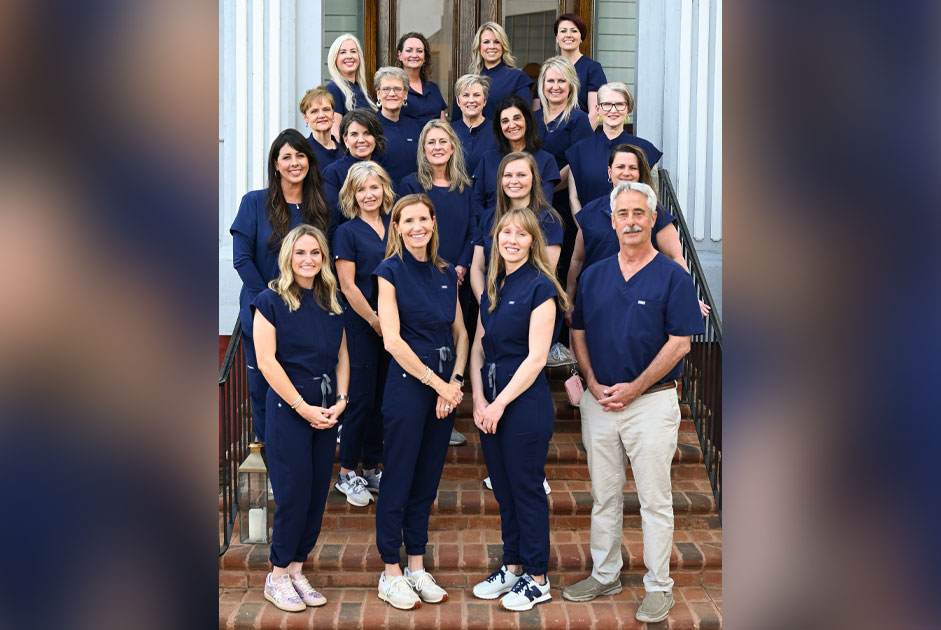Most people have never heard of Lemierre’s Syndrome (LS). Most physicians have never seen, and never will see, even one case. If you’re a parent, however, you need to know about this rare, potentially fatal disease that mostly affects otherwise healthy teens and young adults, usually between the ages of 15 and 30. Even though LS is caused by bacteria that most of us carry, the disease is so rare that it’s often misdiagnosed or diagnosed too late. That’s why knowing the signs of LS might allow you to recognize it in time to save the life of a young person—maybe even your own child.
In 2015, a 30-year-old Winston-Salem woman, Meredith Bullard, contracted LS. She credits her “rock star PCP” and the outstanding medical sleuthing of others with saving her life. This is her story.
Meredith and her husband, David, were ecstatic. After two years of disappointment and failed fertility treatments, Meredith had finally conceived, thanks to in-vitro fertilization. Now, on December 7th, 2015, through the miracle of ultrasound, they were hearing their baby’s heartbeat for the first time. At this moment, exactly seven weeks and six days into their long-awaited pregnancy, life seemed deliciously sweet. So sweet, in fact, that Meredith paid little attention to the nagging pain in her neck that made it hard for her to turn toward the ultrasound screen.
As the day wore on, the pain got worse, and by evening, it was constant. After a miserable, sleepless night, Meredith’s “pain in the neck” was now excruciating. Enduring the worst pain she had ever known, and with her neck beginning to swell, Meredith anxiously sought help at the walk-in clinic at her doctor’s office. Her primary care doctor took one look at her neck and knew right away that Meredith was in trouble. She had no idea what might be wrong, however. Immediately, she sent Meredith to the emergency department at a small nearby hospital for an ultrasound of her neck.
The ultrasound results were both concerning and puzzling. Meredith recalls, “The look on the technician’s face is one I’ll never forget.” She was hurried on to the emergency department at a larger hospital for an MRI. The results were “code critical” and the news could hardly have been worse: there was a massive infection within a blood clot in Meredith’s right internal jugular vein, and the bacteria had already invaded her lungs, causing pneumonia.
For the next eight days, lying in her hospital bed, Meredith expected to die. Enduring what she describes as “the worst pain in the world,” she initially refused potent pain medications in order to protect the baby she and David had worked so hard to conceive. Her condition was a medical mystery. Nothing added up; nothing made sense. But finally, an emergency room doctor and a radiologist put the puzzle pieces together: Meredith had Lemierre’s Syndrome.
“I was so worried about losing the baby,” Meredith recalls.”
“I must have asked them for ultrasounds at least once every other day to check on her. I had a team of about a dozen doctors and countless residents. I had a PICC line, IV antibiotics, blood thinners, you name it. All but two who saw me had never heard of Lemierre’s. I remember asking when I could Jazzercise again, to which the nurse replied, ‘Baby, you’re really sick.’”
In LS, the lymph nodes in the neck become infected and blood clots form in the large neck veins. The clots break apart, carrying infection throughout the body. In the era before antibiotics, 90% of those with LS died from it. Even with today’s IV antibiotics and anticoagulant therapies, for 4 to18%, LS is still fatal. Meredith literally owes her life to the quick thinking of her primary care doctor and the ER physician and radiologist who solved the mystery. She later learned that if she had gone home after her visit to the walk-in clinic, she would probably have died that night.
Meredith’s ordeal made medical history: hers was the first case report of LS in a pregnant patient following in- vitro fertilization (IVF).* After 6 weeks of IV therapy, a month of home health care, and a very carefully monitored pregnancy, Meredith was prepared when the birth-day finally arrived. But LS had one more scary moment in store for Meredith. “I knew in my gut something was wrong,” she said, “because I had arm pain. And sure enough, I had developed another clot during labor.” Despite the clot, which meant an extra day in the hospital, the new parents celebrated the birth of their healthy baby girl, Julia. Fast forward to 2020, both Mom and Julia, now four years old, are doing great!
Ten Facts about LS that Parents Should Know
- Although LS is very rare, cases have been on the rise in the past decade.
- LS usually occurs after a sore throat or tonsillitis, but sometimes it follows a sinus infection, dental infection, or ear infection.
- First symptoms typically include pain on one side of the neck, severe sore-throat, fever, and neck swelling. Symptoms may worsen to include difficulty swallowing, chest pain, joint pain, or coughing up blood.
- Because LS is so rare, it may be misdiagnosed as mononucleosis, flu, strep throat, pneumonia, or a viral upper respiratory infection.
- Untreated LS can cause kidney failure, brain abscess, infected joints, meningitis, the collection of pus between the lungs and the chest wall, or other problems related to infection.
- LS is most often caused by the Fusobacterium necrophorum bacterium. Other bacterial culprits include streptococci and staphylococci.
- The main treatment for LS is intravenous (IV) antibiotics. Other treatments may include blood thinners or surgery to drain pus.
- LS most often occurs at the end of winter or the beginning of spring.
- If you suspect LS, you must act quickly. Have your child evaluated for this rare, but very serious disease.
- For more information see:
What is Lemierre’s Syndrome? everydayhealth.com/lemierres-syndrome/guide/
Lemierre’s syndrome: An often-missed life-threatening Infection ncbi.nlm.nih.gov/pmc/articles/PMC3963201/
Lemierre’s Syndrome rarediseases.info.nih.gov/diseases/6882/Lemierre’s-syndrome
* “Lemierre’s Syndrome in Pregnancy Achieved with In- Vitro Fertilization,” Journal of Reproductive Endocrinology & Infertility, Vol. 2, No. 1:16, 2017.



















